
The 101st Airborne Division (Air Assault) ("Screaming Eagles") is a light infantry division of the United States Army that specializes in air assault operations. It can plan, coordinate, and execute multiple battalion-size air assault operations to seize terrain. These operations can be conducted by mobile teams covering large distances, fighting behind enemy lines, and working in austere environments with limited or degraded infrastructure. Its unique battlefield mobility and high level of training have kept it in the vanguard of U.S. land combat forces in recent conflicts: for example, foreign internal defense and counterterrorism operations in Iraq, in Afghanistan in 2015–2016, and in Syria, as part of Operation Inherent Resolve in 2018–2021.

The United States Army Special Forces (SF), colloquially known as the "Green Berets" due to their distinctive service headgear, are a special operations force of the United States Army.

The 160th Special Operations Aviation Regiment (Airborne), abbreviated as 160th SOAR (A), is a special operations force of the United States Army that provides helicopter aviation support for special operations forces. Its missions have included attack, assault, and reconnaissance, and these missions are usually conducted at night, at high speeds, low altitudes, and on short notice.
United States special operations forces (SOF) are the special forces of the United States Department of Defense's United States Special Operations Command (USSOCOM) within the United States Armed Forces, used for special operations.

The United States Army Special Operations Command (Airborne) (USASOC ( YOO-sə-sok)) is the command charged with overseeing the various special operations forces of the United States Army. Headquartered at Fort Liberty, North Carolina, it is the largest component of the United States Special Operations Command. It is an Army Service Component Command. Its mission is to organize, train, educate, man, equip, fund, administer, mobilize, deploy and sustain Army special operations forces to successfully conduct worldwide special operations.
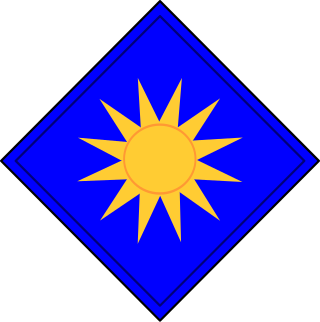
The 40th Infantry Division is a modular division of the United States Army. Following the army's modularization the division has become a four-brigade combat team with National Guardsmen from throughout the Pacific/Western United States and Oceania. Its division headquarters is located at Los Alamitos Joint Forces Training Base in Los Alamitos, California.

Operation Gothic Serpent was a military operation conducted in Mogadishu, Somalia, by an American force code-named Task Force Ranger during the Somali Civil War in 1993. The primary objective of the operation was to capture Mohamed Farrah Aidid, leader of the Somali National Alliance who was wanted by the UNOSOM II in response to his attacks against United Nations troops. The operation took place from August to October 1993 and was led by US Joint Special Operations Command (JSOC).

Operation Prime Chance was a United States Special Operations Command operation intended to protect U.S.-flagged oil tankers from Iranian attack during the Iran–Iraq War. The operation took place roughly at the same time as Operation Earnest Will, the largely naval effort to escort the tankers through the Persian Gulf. The operation was begun after the mining of the U.S.-flagged Kuwaiti oil tanker Bridgeton.
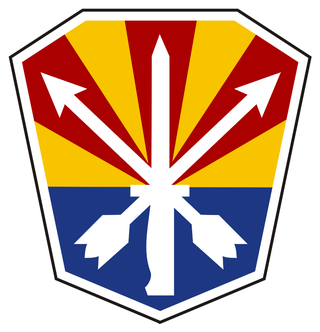
The Arizona Army National Guard is a component of the United States Army and the United States National Guard. National coordination of various state National Guard units are maintained through the National Guard Bureau.

The Oklahoma Army National Guard is the Army National Guard component of the Oklahoma National Guard. The Commander in Chief of the Oklahoma National Guard is the Governor of Oklahoma, who appoints the State Adjutant General (TAG), a Major General from either Army or Air. Currently, the TAG is Brig. Gen. Thomas H. Mancino. The previous TAG was Maj. Gen. Michael Thompson.

The United States Marine Corps is organized within the Department of the Navy, which is led by the Secretary of the Navy (SECNAV). The most senior Marine commissioned officer is the Commandant of the Marine Corps, responsible for organizing, recruiting, training, and equipping the Marine Corps so that it is ready for operation under the command of the unified combatant commanders. The Marine Corps is organized into four principal subdivisions: Headquarters Marine Corps, the Operating Forces, the Supporting Establishment, and the Marine Forces Reserve.
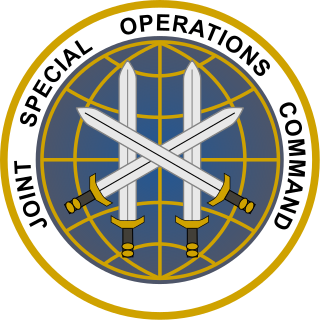
The terms Tier One Special Mission Unit and Special Missions Unit (SMU) are used, particularly in the United States, to describe some highly secretive military special operations forces. Special mission units have been involved in high-profile military operations, such as the killing of Osama bin Laden.

In the United States (US) military, a beret flash is a shield-shaped embroidered cloth that is typically 2.25 in (5.72 cm) tall and 1.875 in (4.76 cm) wide with a semi–circular base that is attached to a stiffener backing of a military beret. These flashes—a British English word for a colorful cloth patch attached to military headgear—are worn over the left eye with the excess cloth of the beret shaped, folded, and pulled over the right ear giving it a distinctive appearance.

Lieutenant General John F. Mulholland Jr. is a retired senior officer who served in the United States Army and is the former Associate Director for Military Affairs (ADMA) at the Central Intelligence Agency. LTG Mulholland previously served as Deputy Commander of the United States Special Operations Command, after having previously served in the US Army's Special Forces. He commanded special operations task forces in both Operation Enduring Freedom and Operation Iraqi Freedom, earning an appointment as Deputy Commanding General of the Joint Special Operations Command and later as Commanding General, US Army Special Operations Command at Fort Bragg.
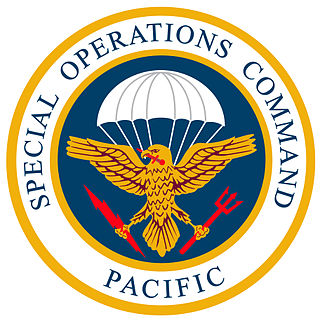
The Special Operations Command Pacific, known as SOCPAC, is a sub-unified command of the United States Department of Defense for special operations forces in the United States Indo-Pacific Command (USINDOPACOM) area of responsibility.

The Special Operations Command Central (SOCCENT) is a sub-unified command of the U.S. Central Command (CENTCOM). It is responsible for planning special operations throughout the CENTCOM area of responsibility (AOR), planning and conducting peacetime joint/combined special operations training exercises, and orchestrating command and control of peacetime and wartime special operations as directed.

General Raymond Anthony Thomas III is a retired general officer of the United States Army and former commander of the United States Special Operations Command.
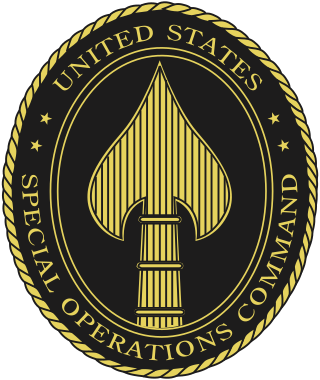
The United States Special Operations Command is the unified combatant command charged with overseeing the various special operations component commands of the Army, Marine Corps, Navy, and Air Force of the United States Armed Forces. The command is part of the Department of Defense and is the only unified combatant command created by an Act of Congress. USSOCOM is headquartered at MacDill Air Force Base in Tampa, Florida.

The United States Army Special Operations Aviation Command (USASOAC) provides command and control, executive oversight, and resourcing of U.S. Army Special Operations Command (USASOC) aviation assets and units in support of national security objectives. USASOAC is responsible for service and component interface; training, doctrine, and proponency for Army Special Operations Aviation (SOA); system integration and fleet modernization; aviation resource management; material readiness; program management; and ASCC oversight. USASOAC was established March 25, 2011 consisting of 135 headquarters soldiers and subordinate units totaling more than 3,300 personnel, include the 160th Special Operations Aviation Regiment (Airborne), (160th SOAR (A)) which features 4 Aviation Battalions, the USASOC Flight Company, the Special Operations Aviation Training Battalion, the Systems Integration Management Office, and the Technology Application Projects Office. The first commander of USASOAC was Brig Gen. Clayton M.Hutmacher.

Richard D. Clarke Jr. is a retired United States Army four-star general who last served as the 12th commander of United States Special Operations Command from March 29, 2019 to August 30, 2022. Prior to assuming command of USSOCOM, General Clarke served as Director for Strategic Plans and Policy (J5), Joint Staff, the Pentagon, Arlington, Virginia.






























